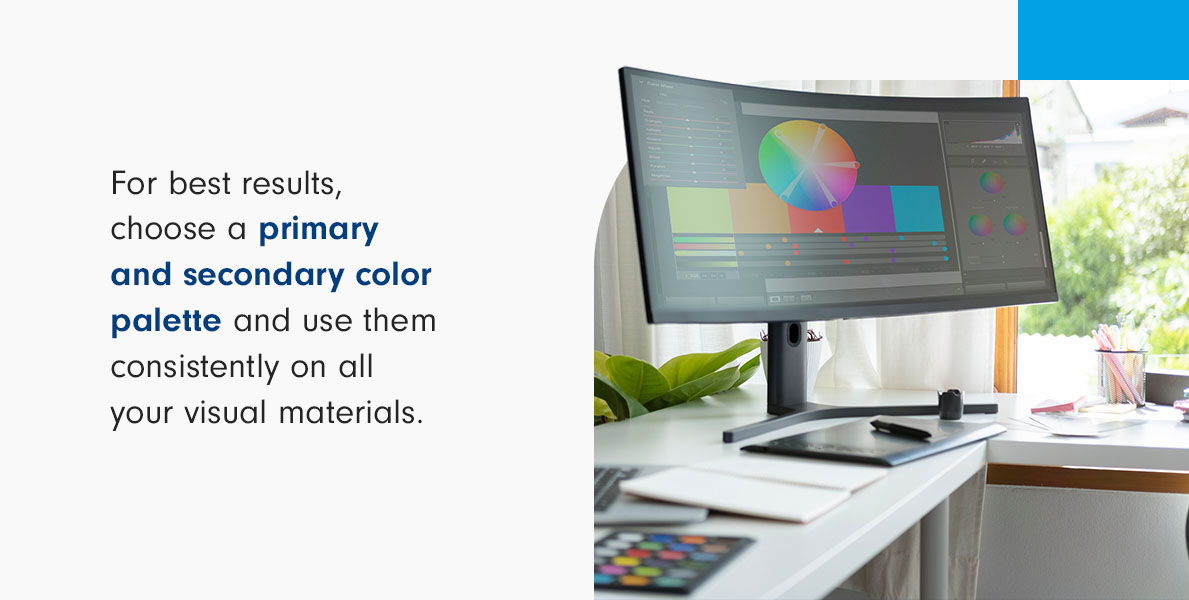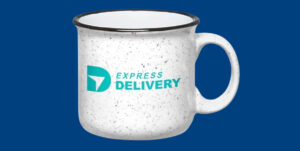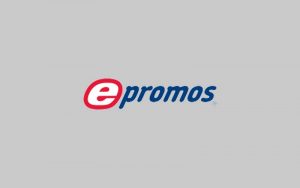04/29/2024
How to Build Your Brand’s Visual Identity
You know your business is unique — but with approximately 333.34 million companies in the world to compete with, how do you ensure your customers choose your services? Building a strong visual identity is one of the most effective ways to create a lasting first impression.
Our guide will explain the significance of a robust visual identity and how it impacts your success. We’ll also provide a comprehensive step-by-step breakdown of how to inspire a brand image that instantly sets your business apart from the rest.
Understanding Visual Identity
Visual identity, brand image and brand identity are terms that are often used interchangeably. However, they are distinctly different and denote separate aspects of your brand strategy. Here’s a brief overview of these common branding terms to help you clarify the concept of visual identity:
- Brand: Your business values, mission, voice, products and even pricing comprise your brand. In other words, a brand is a combination of all the tangible and intangible aspects of your company.
- Brand identity: The combination of your tone, voice and visual assets comprise your brand identity. Customers use these visual and non-visual elements to form an opinion of your company.
- Brand imaging: A visual brand identity is based on the visual components of your brand. Aspects of a visual identity include imaging like your logo, branding colors, fonts and more.
- Brand reputation: Customers are the lifeblood of your business and their overall impression constitutes your brand’s reputation.
To put these terms into context, let’s use world-renowned sports brand Nike as an example. Customers associate Nike with innovation, dominance and high performance — these qualities define their brand identity. On the other hand, the distinctive check mark on all their products is an element of their visual identity. Consumers use both these branding aspects to determine an overall image of the brand.

Why Visual Identity Matters
From supplying quality products to maintaining a high level of customer service, there is an endless list of things to focus on when running a business. Your visual identity is another aspect that deserves a top spot on your priority list. Discover some of the top reasons why a strong visual identity matters.
Brand Recognition
Brand recognition refers to your target market’s ability to identify your products and services based on branding elements, such as taglines, logos or colors. As customers are likely to have multiple suppliers to choose from, a strong brand recognition strategy helps to ensure they pick your company over your competitors.
Using consistent visual elements boosts brand recognition, resulting in increased sales and improved customer retention.
Brand Trust
Customers work hard for their money — as such, they want to ensure they’re getting good value from their purchases. Establishing a strong brand identity helps to cement your business as credible.
If you’re planning to sell your products online, brand trust is particularly important. Statista reveals that e-commerce purchases are on a steady incline, with 21% of all sales taking place online by 2025. Creating a robust visual identity will give your customers greater peace of mind as they add additional items to their carts.
Emotional Connections
Product pricing and quality are important factors in purchasing decisions, yet customer emotions are an even bigger driving force behind sales. In fact, research by Harvard professor Gerald Zaltman’ suggests that humans make up to 95% of all decisions in their subconscious mind.
Creating a witty tagline, appealing logo and inspiring imagery helps to connect with your audience on a deeper level. Using your visual identity to establish strong emotional connections makes your brand more memorable.

Product Unity
Successful businesses often diversify their product and service offerings to ensure they meet the needs of a multifaceted customer base. For example, a business that specializes in cleaning services could also develop an at-home cleaning product range to reach a variety of customers.
Placing your logo on the staff’s cleaning uniforms and product packaging is one way to assimilate the two different offerings. However, you can take it a step further by using the same color palette, typography and image styles to connect both aspects of your business.
The Elements of a Visual Identity
Five core elements comprise a brand’s visual identity. Each of these visual components plays an integral part in establishing your brand as unique. Here’s a more in-depth explanation of the various elements and their impact on your brand.
1. Logo and Brandmarks
A logo is a combination of stylistic images and typography. It often incorporates your brand colors and gives a visual clue about your service offerings. On the other hand, a brand mark is a symbol without text. While it’s always possible to change your logo or brand mark, it’s worth putting in the effort at the start so customers come to instantly recognize your brand. One of the oldest logos still in existence today is Stella Artois. They’ve been trading under the same star-shaped icon for over 600 years, establishing themselves as a leading brewery for generations.
A simple logo is often most effective, helping customers to quickly identify your brand when they catch a glimpse of it. You can achieve this by adding symmetrical patterns, harnessing contrast and balancing imagery with white space.
2. Color Scheme
The colors you choose to convey your brand are another crucial part of your visual identity. As color psychology suggests that the various hues have a powerful impact on our emotions, it’s worth considering how you want your customers to feel when picking your palette. For example, using red tones could convey a sense of urgency whereas yellow hues may trigger positivity.
For best results, choose a primary and secondary color palette and use them consistently on all your visual materials. Places to incorporate your color scheme include your logo design, signage, background colors and even fonts for a cohesive image.

3. Typography
Typography refers to arranging type in a way that is legible and visually appealing. The term is often used interchangeably with typeface and font, yet they are all distinctly different. Typeface refers to a distinctive style of type while fonts denote the weight within a typeface family. For example. Times New Roman is a typeface, yet you can select this typeface in multiple fonts, such as bold or italics.
Typography is another visual way to express the mood of your brand. For example, a heavy block type may resonate well with a more fact-seeking audience whereas a flowy script may appeal to those who are more creative.
4. Imagery and Graphics
In the context of visual identity, imagery refers to photos and videos while the term graphics denotes hand-drawn or designed pictures. Both these brand assets play a pivotal role in your visual identity as they help the human brain process information quickly and form connections.
When choosing graphics and images for your brand, it’s essential that you consider your brand’s personality and audience. Choosing photos and videos that convey the mood or tone you want your audience to feel helps to connect with their emotions. Similarly, capturing images that represent the same demographics as your audience will help them envision themselves using your products or services. While using consistent imagery is more challenging than placing an identical logo on each brand asset, it’s important that your photographer has a clear idea of your branding to ensure a coherent brand identity.

5. Layouts and Grids
Balancing white space with visual elements creates appealing designs. Grids and layouts are instrumental in the organization of your visual elements across brand assets. Here’s an overview of the different grid types and their uses:
- Hierarchical: Website designs rely on hierarchical grids to organize content according to its relevance.
- Manuscript: These grids are a common choice for ebooks, PDFs and documents with extensive text.
- Column: A column grid helps organize magazine content for increased legibility.
- Modular: This grid type is likened to a checkerboard, enabling users to engage with content easily.
- Baseline: The line where the text sits classifies these grids. They’re a good option for designs that are heavy on text.
Steps to Create a Strong Visual Identity
Now that you know how crucial a strong visual identity is for your ongoing success, it’s time to create one of your own. Whether you’ve been in business for years or you’re just starting off, here are some tried-and-tested tips to build a robust brand image.
1. Define Your Brand Personality
Brands — just like humans — embody a collection of qualities that define their personality. By showcasing your brand’s unique traits, you attract like-minded customers to your business. For example, if your business exemplifies innovation, reflecting your out-of-box way of thinking will appeal to people who value this characteristic.

A good way to contextualize this is with the five core brand personality types:
- Sincerity: Qualities such as honesty, humility and wholesomeness encapsulate this brand personality type.
- Excitement: Brands that reflect qualities such as spontaneity, sportiness and outgoingness fall into this category.
- Competence: Companies showcase this trait by providing reliable services and appointing noteworthy leaders.
- Sophistication: Traits such as elegance and luxury form the basis for this brand personality.
- Ruggedness: Outdoorsy companies that pride themselves on long-lasting and durable products fit this description.
Defining your personality is the first step to creating your visual identity. If you don’t feel an instant pull towards one of these categories, conduct a strengths, weaknesses, opportunities and threats (SWOT) analysis.
2. Understand Your Audience

Your target audience is the group of people who will buy your product. As the needs, wants and pain points of a college student are likely vastly different from a working mom, you need to narrow down your audience before creating your visual identity. One way to establish your target audience is to analyze your current sales and identify commonalities along the following factors:
- Age
- Gender
- Location
- Level of education
- Level of purchasing power
- Social class
- Purchasing habits
Once you’ve collected this data, you can use it to form the basis of a core buyer persona. This information will help you choose color combinations, imagery and typography that appeal to your target audience, helping to generate more sales.
3. Research Competitor Brands
There’s a popular expression that advises you to keep your friends close and your enemies closer. This pearl of wisdom is particularly relevant in the marketing context, as competitor research is often one of the best sources of learning. While you don’t want your visual identity to be a carbon copy of your competitors, there’s a lot to learn from brands selling similar products and services. Here’s how you can use aspects of their visual identity to inspire your own:
- Logo: Consider how they use symbols and typography to depict their service offering. If their logos evoke certain emotions, note these down for reference.
- Color palette: Identify their primary and secondary color schemes as well as any powerful color combinations.
- Typography: From their font choice through to the page alignment, there’s a lot that you can learn about your competitor from their typography.
- Imagery: One of the most effective ways to assess the effectiveness of your competitor’s images is to look into their social media engagement and what their most successful posts look like.

4. Choose Your Visual Elements
Defining your personality, audience and competitors provides some key insights to help you choose the right visual elements. Here are some additional tips:
- Gather ideas: Scan the internet and Pinterest and create a mood board with images, typography options and logo styles you feel encapsulate your brand.
- Run a focus group: Once you’ve created a mood board with your ideas, distribute it among members that represent your target audience and solicit their feedback.
- Work with a professional: You know your brand best of all, but there’s no harm in working with a designer or brand consultant to help you choose the best elements for your visual identity.
5. Create Consistent Designs
The designs you choose to reinforce your visual identity are likely to appear across various social media platforms, physical signage, web pages and more. Ensuring these designs remain consistent in all aspects begins with outlining clear brand guidelines. These guidelines may specify the following:
- Logo placement
- The inclusion of in-image text
- Preferred color palette
In creating your brand guidelines, it’s helpful to include visual examples of what matches your brand style. Similarly, you can include images of what goes against your brand. As there may be multiple people working on the different branding aspects, clear guidelines help to ensure everyone delivers consistent outcomes.
6. Test and Refine
Before adopting a visual identity, it’s a good idea to test its effectiveness with your audience. A/B testing is one method that will help you measure the success of visual elements. This testing approach involves comparing two elements and tracking the responses from your audience. For example, if you’re deciding between two logo options, you could produce two flyer designs, each displaying a different logo and monitor the responses.
The Role of Visual Identity in Promotional Products
Promotional products are customized items that brands give to clients and employees. There are several benefits of handing out quality freebies, including increased brand awareness and enhanced customer relationships. Whether you choose to customize caps, travel tumblers or apparel, you gain a versatile canvas to display your visual identity. Discover some ways to depict your brand:
- Use your brand colors: Promotional products come in a plethora of colors — choose items in the same shade as your brand colors to enhance your visual identity.
- Factor in logo placement: Many companies choose products from high-end brands to strengthen their reputation. Consider how the placement of the product logo will complement your own when selecting promotional items.
- Design for the material: From water bottles to umbrellas, promotional products come in all forms and sizes. Each item has it’s own imprint area, which will determine how well your image or message will display.

ePromos has helped several companies convey their visual identity through promotional products. Here are just a few examples:
- American Express: Our team partnered with this multinational financial services corporation to unify its visual identity across point-of-purchase solutions.
- Samsung: We worked with international electronics giant Samsung to provide them with unique kits for a new product launch. In addition, we furthered their brand awareness with compact and movable artwork for retail spaces.
- Veeam: From printed postcards to day-of-event kits, we enhanced Veeam’s visual identity with customized gifting elements.
Tips for Keeping Your Visual Identity Fresh
In the business world, change is not only expected — it’s essential for your long-term success. While it’s worth creating a visual identity that will serve you in the future, a brand image refresh is sometimes necessary. Telltale signs that may indicate it’s time for a new visual identity include:
- Outdated designs: The logo you chose 10, 15 or even 20 years ago may seem old-fashioned in the eyes of your current market. A refresh will help give your business a modern stance.
- Lack of engagement: If the number of users engaging with your content is dwindling, your content might be missing the mark. A refresh can help your brand resonate more effectively with your audience.
- Business changes: From expanding your product range to focusing on different services, businesses are constantly evolving to meet customer needs. If your business has undergone significant changes, a visual identity refresh will help to convey your mission.
If you decide it is time for a refresh, then you’ll want to ensure all changes are carried out consistently. Here are some quick tips to help you achieve a cohesive visual identity during an overhaul:
- Start with an audit: Keeping some elements of your current visual identity will resonate with your current client base. Survey each element of your brand image — logo, typography and imagery — and define the strengths and weaknesses. You’ll then have a better idea of which areas to improve.
- Define clear goals: Whether you want your visual identity to reflect your new products or appeal to new audiences, defining your goals from the get-go will give you a clear direction forward.
- Review brand guidelines: Once you’ve made the desired changes, take a moment to update your brand guidelines. Clearly expressing the components of your new visual identity will help your marketing team follow along the same path.
Showcase Your Visual Identity With Promotional Products
Promotional products are one of the most effective ways to display your visual identity, as they provide a surface to display your logo and brand colors. ePromos offers an extensive range of high-quality promotional items, just waiting for your logo! Whether you choose to customize stationery, drinkware or tech accessories, we’ll work with you to ensure your distinctive visual identity is reflected on the product.
For more information about our services, speak to one of our brand consultants today or explore some frequently asked questions.







